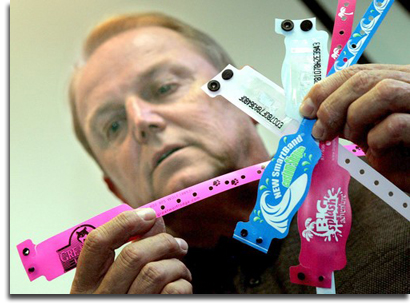 Robin Barber, Vice President of RFID wristband manufacturer Precision Dynamics, displays wristbands that the company has produced for various theme parks (Los Angeles Times)
Robin Barber, Vice President of RFID wristband manufacturer Precision Dynamics, displays wristbands that the company has produced for various theme parks (Los Angeles Times)Hoping for more information to emerge about the rumored NextGen / Personal Experience Portal project, I was fascinated to see an article in the Los Angeles Times today about Precision Dynamics Corp. The California company was founded fifty years ago to manufacture wristbands for hospital patients, but has found success in recent years creating RFID bands for amusement parks and attractions.
Using the new technology, the article says, the wristbands can be used as “high-security admission passes, cashless debit cards, hotel room keys and a form of identification to reunite lost children with parents.” These are all possible uses that have been mentioned for Disney’s “X-Band” program as well. The Precision Dynamics wristbands broadcast a unique 16-character code when triggered by a reader, which then uses the code to serve as an access key for debit accounts or electronic door locks. In Disney’s plan, it could also be used to access pre-recorded guest information to enable interactive features within the parks themselves.
It’s unknown whether Disney is working with Precision Dynamics or developing a technology of their own, but as Precision Dynamics holds a patent on their design it’s unsure how much leeway Disney would have in duplicating the idea. Disney’s interest in the technology is understandable; the Times article points out that guests using wristbands tend to spend up to 25% more at parks and resorts due to the ease (and, one assumes, the “Monopoly money” factor) of cashless transactions. The RFID chips are programmable, allowing guests to add amounts to their families’ wristbands at kiosks throughout the park.
The article underlines a few concerns about the technology as it stands now. The first is cost; RFID wristbands sell for $1 apiece, while the computerized readers cost $450. While this would obviously be small change for Disney, it would require a substantial initial outlay if they were to roll out the technology across all the resorts. One suspects that the cost of the wristband would be passed along to the consumer, which would only add to already-steep admission fees.
Privacy concerns are also a critical issue when this technology is discussed. The general public might not yet be aware of RFID, but the privacy and tech-savvy communities have had their eye on it for years. Precision Dynamics says that the wristbands must pass within inches of a reader to be activated, and that they’re programmed to expire after a single day’s use. RFID advocates say the technology is secure, but no doubt Disney would want to rigorously test this rather than risk turning Walt Disney World into a global magnet for “haxors” and scam artists.
Disney isn’t mentioned in the article, so it’s mere speculation to connect the Precision Dynamics wristbands with Disney’s own plans. Still, it gives a glimpse into what this technology is being used for now, and what direction Disney might go in the future.









All right, last comment tonight. Interesting enough, this technology seems to be the antithesis of the spirit exuded in Liberty Square. The pros and cons already have been touched on, but I can’t shake the feeling of being tracked as life long guest # 2414 B 24312965641422. Certainly someone will say we are already there, as it is with the guest cards and all, but that’s at the adult level. The RFID band with the implications it poses for our children is unfair. Logan’s Run anyone?
Hey, they already have a carousel in Fantasyland
I’m less concerned about Disney’s use of the tech than possible infiltration and abuse of the system by outsiders. We all know Disney is trying to track as much information as possible, I guess I don’t mind if they’re actually accurate. I’m always kvetching that they don’t carry the kind of things that I’d like to buy – if this helps them figure that out, then I don’t mind too much.
NOT NEW TECHNOLOGY
Not sure when the LA Times article came out but this technology is already out there. Just visit a Great Wolf lodge (see band in picture) Personally I feel more secure carrying a wristband than a hotel key card or getting my wallet stolen.
KIDS and PRIVACY
As far as kids I believe some cruise ships already track kids with tied-on tags now. I doubt Disney would really want to track which rides every single child went on and which gift shops he/she walked through. Too much data. Tradeshows do this now with UV dots on a small sampling of patrons to look at crowd movements.
HACKING BY OUTSIDERS
This is very remote at best. The built in security for the readers, the chips and the proximity needed would make it very difficult to gather any data. The time spent trying to hack would be better spent planning a bank robbery.
Personally, I would never participate in or patronize any business who uses RFID, especially “item-level” or on-person tracking. It is too bad that there are not more like me as I fear this “innocuous technology” will find far more nefarious applications in the very near future. The sheeple will not resist it for even a nanosecond if they “think” perceive it makes their self-important, busy lil’ lives easier. The range of these devices will certainly improve as will the many devious ways corporations and governments will use them. IT IS A FACT!
In 20 years or less the brain-dead, “mass-mediatized,” drugged-out, “American Idol-ized,” sheeple’s children will wonder how anyone got along with out “their chip” that was implanted at birth.
Oh boy looks like a can o’ worms has been opened…. Good points all (and that includes the carousel comment! Yuk yuk). No short changing yours either MJ, believe me, I often share in the same beliefs, otherwise I would have never let my reservations be known. But since this is a Disney blog, I’ll try to focus on why I don’t like the idea there, assuming of course that it will be even used, or as a ”personal experience” device, or more keenly, on children. says the very young are not prepared.
says the very young are not prepared.
Just look back onto our own childhood, the fears, the faith, and the hopes, and what influences had shaped it. Certainly times have changed, and kids are way more tech savvy, but I doubt it can be denied that at a certain stage of growth, types of commercial influences are unwanted. This is my assumption without a little soul searching of where my own problem arises.
So again at the Disney Park level, GULF, GAF, or …. fill in the blank. These were very passive influences indeed: none of those corporations knew who I was (thank God) and had left little exploitable residue other than a warm fuzzy feeling. And yes, with Disney itself, it’s quite obvious what path has been taken today. Why not, it’s easy money,,, but I will speculate for those who hold no qualms about privacy issues, that creativity itself will suffer as an entity looks forever inward for answers.
However, back to the human aspect: there is a certain emotional connect that when revealed, adults learn to cope with, which my amateur psychology ( thanks for the term Foxx
The Disney experience should be personal, arguably young or old. This goes beyond Pal Mickey telling you when the next parade is. I’m stating that the problem is when this technology is used for more than the convenience of keeping your wallet dry, or a prompt to the bean counters, saying hey people do like the Swiss Family Treehouse. Instead it becomes more of a “Jimmy, what a great job you’ve done, we’re so proud of you! Come over to Main Street Athletics and we want to reward you… with a sales pitch to the family, and a life long ad campaign, sold, expanded and exploited, starting with that early and personal connection. Not right. Not fair, when that data now follows you from 3 instead of 30.
Heck it’s late, and I got to work tomorrow. (and no Hi Ho off to a data mining company I go =)
[…] Have we found our X-Band? (ProgressCityUSA) […]